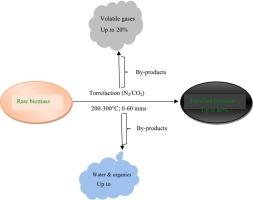碳化技术的现状概述,其局限性,和未来的解决方案:一个反应堆设计和性能的观点
IF 7.5
1区 工程技术
Q2 ENERGY & FUELS
引用次数: 0
摘要
焙烧的目标是将木质纤维素生物质转化为具有比原料生物质更好特性的固体产品。当通过气化和直接燃烧等热化学过程将生物质转化为最终的能量载体时,预热特别有用。然而,尽管碳化生物质已显示出优越的质量,但目前流行的碳化方法尚未被认为足够先进,无法克服某些操作困难,例如在温度、反应时间和粒度等重要独立变量之间找到适当的平衡;因此,获得的许多固化产品表现出不一致的特性。该技术还缺乏有效处理各种生物质原料的能力,并且存在扩大规模的问题,这些问题可能与温度控制不良和热量分布不均匀有关。许多现有的焙烧系统已被开发和验证用于木质材料的加工。对非木质材料进行的研究结果并不令人满意,因为它们在焙烧过程中容易点燃和碳化。因此,本文概述了碳化技术的现状,并从反应堆设计的角度讨论了该技术的局限性,并确定了可能有助于解决该技术限制的系统级研究。还讨论了焙烧的基本原理和影响焙烧产物质量的机理,包括关键的过程变量和动力学。其他阐述的方面包括反应堆设计概念、过程监测和控制,以及被认为阻碍该技术试图取得商业成功的具体技术障碍。本文章由计算机程序翻译,如有差异,请以英文原文为准。

Status overview of the torrefaction technology, its limitations, and prospective solutions: A reactor design and performance viewpoint
The goal of torrefaction is to transform lignocellulosic biomass into a solid product with better characteristics than raw biomass. Torrefaction is especially helpful when converting biomass into a final energy carrier via thermochemical processes like gasification and direct combustion. However, even though torrefied biomass has demonstrated advantageous quality, the prevailing torrefaction methods are not yet considered sufficiently advanced to overcome certain operational difficulties such as finding the proper balance between salient independent variables like temperature, reaction time and particle size; hence, much of the torrefied products obtained exhibit inconsistent properties. The technique also lacks the ability to efficiently handle a wide range of biomass feedstocks and exhibits scale-up issues that could be linked to poor temperature control and non-uniform heat distribution. Many of the existing torrefaction systems have been developed and validated for use in the processing of wood-based materials. Studies performed with non-woody materials yielded unsatisfactory results due to their inclination to ignite and carbonize readily during torrefaction. This review, therefore, presents a status overview of torrefaction technology and discusses the limitations of the technique from a reactor design perspective, as well as identifies system-level research that could potentially help to address the technology’s constraints. The basic principles of torrefaction and the mechanisms that affect the quality of torrefied products, including key process variables and kinetics are also discussed. Other expounded aspects include reactor design concepts, process monitoring and control, and specific technological barriers thought to hamper the technology’s attempt to achieve commercial success.
求助全文
通过发布文献求助,成功后即可免费获取论文全文。
去求助
来源期刊

Fuel
工程技术-工程:化工
CiteScore
12.80
自引率
20.30%
发文量
3506
审稿时长
64 days
期刊介绍:
The exploration of energy sources remains a critical matter of study. For the past nine decades, fuel has consistently held the forefront in primary research efforts within the field of energy science. This area of investigation encompasses a wide range of subjects, with a particular emphasis on emerging concerns like environmental factors and pollution.
 求助内容:
求助内容: 应助结果提醒方式:
应助结果提醒方式:


